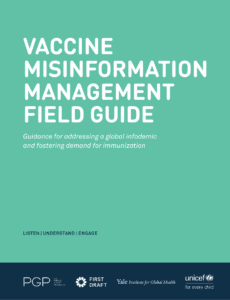Misinformation Alerts
Knowing what misinformation is being shared can help you generate effective messaging.
These insights are based on a combination of automated media monitoring and manual review by public health data analysts. Media data are publicly available data from many sources, such as social media, broadcast television, newspapers and magazines, news websites, online video, blogs, and more. Analysts from the Public Good Projects triangulate this data along with other data from fact checking organizations and investigative sources to provide an accurate, but not exhaustive, list of currently circulating misinformation.
Misinformation Alerts
Knowing what misinformation is being shared can help you generate effective messaging.
These insights are based on a combination of automated media monitoring and manual review by public health data analysts. Media data are publicly available data from many sources, such as social media, broadcast television, newspapers and magazines, news websites, online video, blogs, and more. Analysts from the Public Good Projects triangulate this data along with other data from fact checking organizations and investigative sources to provide an accurate, but not exhaustive, list of currently circulating misinformation.Alerts are categorized as high, medium, and low risk.
- High risk alerts: Narratives with widespread circulation across communities, high engagement, exponential velocity, and a high potential to impact health decisions. Are often more memorable than accurate information.
- Medium risk alerts: Narratives that are circulating in priority populations and pose some threat to health. Potential for further spread due to the tactics used or because of predicted velocity. Often highlights the questions and concerns of people.
- Low risk alerts: Narratives that are limited in reach, don’t impact your community, or lack the qualities necessary for future spread. May indicate information gaps, confusion, or concerns.
A widely circulated post claims that the WHO administered 50 million smallpox vaccines in Africa that were laced with HIV. The post includes an image of a 1987 news article promoting the conspiracy theory that vaccines “triggered the AIDS virus.”
Recommendation: The persistence of this myth increases its risk. Debunking messaging may explain why the conspiracy theory was immediately and universally rejected by experts, who note that the same smallpox vaccines were administered globally without triggering an AIDS outbreak. Fact Checking Source(s): Full Fact
Some social media accounts expressed outrage over a Pfizer ad about future cancer treatments that aired during the Super Bowl. Some posts criticized a starting player’s participation in a previous Pfizer COVID-19 vaccine ad, while others accused the pharmaceutical giant of producing cancer drugs to treat so-called “turbo cancers” allegedly linked to COVID-19 vaccines.
Recommendation: The claims received considerable attention—and pushback—due to the high-profile nature of the game. Debunking messaging may explain that turbo cancer is a made-up term circulated by vaccine opponents and that the claim that mRNA COVID-19 vaccines cause or accelerate cancer is an anti-vaccine myth. Talking points may emphasize that over three years of scientific research and safety monitoring have found no link between any COVID-19 vaccine and cancer. Fact Checking Source(s): FactCheck, Science-Based Medicine 
Several vaccine opponents published a review article that questions mRNA COVID-19 vaccine safety. The paper calls to ban the vaccines and promotes the baseless claim that COVID-19 vaccines killed 14 times as many people as they have saved.
Recommendation: Fact-Checking Source(s): PolitiFact, CIDRAP
Many posts sharing the paper emphasize its peer-reviewed status, which lends it the appearance of credibility. Messaging may highlight that although the paper is peer-reviewed, it is published in a journal that has been labeled “predatory” and has been criticized for its controversial post-publication peer-review process. Messaging may also emphasize that the review’s claim about vaccine-related deaths is based on unverified and noncredible data. Independent analyses of global data estimate that COVID-19 vaccines have saved millions of lives worldwide.
A popular video circulating online repeats the false claim that vaccine manufacturers suppressed hydroxychloroquine and ivermectin to ensure the authorization of COVID-19 vaccines.
Recommendation: The persistence of false claims about fake COVID-19 cures increases their risk. Debunking messaging may emphasize that both hydroxychloroquine and ivermectin have been subject to large clinical trials and were found to be ineffective against COVID-19 at any dose or duration. Talking points may continue to highlight data showing the effectiveness of COVID-19 vaccines. Fact-checking sources: KUMC, JAMA, Penn Medicine
During a right-wing political commentator’s interview with a writer who opposes COVID-19 vaccines, there was speculation about the safety of mRNA COVID-19 vaccines. The writer suggested that mRNA vaccines weaken the immune system and promoted the conspiracy theory that China may release a bioweapon targeting those who received mRNA vaccines.
Recommendation: Responding to each conspiracy theory may detract from priority talking points. Continuing to emphasize the well-established safety of COVID-19 vaccines is recommended. Fact-checking sources: CDC
Several trending posts circulate false claims about HPV vaccine safety and effectiveness. The posts falsely claim that HPV vaccines don’t prevent cervical cancer and that the vaccines cause autoimmune diseases, miscarriages, birth defects, and deaths in young adults.
Recommendation: Messaging may highlight that vaccine opponents have circulated myths about HPV vaccines since their introduction in 2006. In the intervening years, hundreds of millions of doses of the vaccine have been administered globally with no serious safety concerns. Data from multiple countries, including the U.S. and the U.K., show a decrease in cervical cancer rates in HPV-vaccinated populations, putting some countries on track to eliminate the disease. Fact Checking Source(s): American Cancer Society, WHO
A former cardiologist who was stripped of his board certification for promoting vaccine disinformation has co-authored two recent papers claiming that COVID-19 vaccines contribute to a large number of myocarditis deaths. One of the papers that was published and withdrawn in 2021 relies entirely on VAERS data and highlights cases of individuals who died 358 and 600 days after vaccination. The second paper, which involved a review of documents from autopsies that the researchers did not perform, was removed from a medical journal’s preprint database because its conclusions were unsupported.
Recommendation: The studies represent a continuation of the anti-vaccine tactic of promoting false claims through preprint, low-quality, and retracted studies. Debunking messaging may emphasize that studies found no evidence that COVID-19 vaccines caused deaths and ignored other more likely causes of death. Large-scale, credible, peer-reviewed studies consistently show that COVID-19 vaccines are safe and that myocarditis is far more common after COVID-19 infection. Fact Checking Source(s): Infectious Diseases Society of America, CBS News
The addition of RSV and COVID-19 vaccines to the CDC’s recommended immunization schedule is being criticized by some online. RSV vaccines are recommended for older adults and pregnant people, and COVID-19 vaccines are recommended for everyone 6 months and older. An anti-vaccine website published an article calling for COVID-19 vaccines to be removed from all immunization schedules.
Recommendation: Opposition to routine vaccines is widespread online. Talking points may highlight that recommended immunization schedules are not requirements. Prebunking messaging may explain that immunization reduces the impact of infectious diseases on individuals and communities. Many decades of research and monitoring have conclusively demonstrated that the risks associated with childhood vaccination are exceedingly low and are far outweighed by the benefits of preventing potentially debilitating and deadly diseases. Messaging may also emphasize that respiratory infections like the flu, RSV, and COVID-19 pose a higher risk to certain vulnerable populations, including infants, young children, and older and pregnant adults. Fact Checking Source(s): CDC, AMA
A video clip of a medical advisor comparing SARS-CoV-2 and long COVID to HIV and AIDS led some to claim that long COVID is actually a vaccine injury called vaccine AIDS, or “VAIDS.” A former cardiologist resurfaced the debunked myth that COVID-19 vaccines cause positive HIV tests and that the alleged positive tests are a sign that the vaccine has weakened the immune system.
Recommendation: Debunking messaging may reiterate that “VAIDS” is not a real disease; it is an anti-vaccine myth. Messaging may also explain that the false claim that COVID-19 vaccines cause positive HIV tests is a misrepresentation of a failed COVID-19 vaccine candidate that contained an HIV protein and research showing that some individuals with COVID-19 infections had false positive HIV tests, possibly due to similarities in the viruses’ proteins. There is no record of any COVID-19 vaccine causing positive HIV tests. Moreover, HIV tests detect the presence of HIV, not immunodeficiency, and thus could not possibly detect immune damage due to HIV, COVID-19, or any other cause. Fact Checking Source(s): Reuters, Health Feedback
A popular right-wing commentator voiced opposition to all childhood vaccines, calling for a class action lawsuit against pediatricians who don’t accept unvaccinated children at their practices. The commentator also promoted the false claim that doctors receive “bribes” for encouraging their patients to get vaccinated.
Recommendation: In recent years, trust in vaccines and childhood vaccination rates have declined as anti-vaccine rhetoric has become more mainstream. Messaging may emphasize that, unlike most drugs and medical treatments, routine vaccines are mass administered to a primarily young and healthy population. Because of this, vaccines are held to higher testing and safety standards than almost any other medical intervention. All vaccines, new and old, must undergo rigorous safety trials and are closely monitored by health authorities for as long as they are in use. Debunking messaging may also explain that insurance incentive programs require doctors to meet a variety of performance goals related to the quality of patient care and health outcomes, including timely vaccinations, regular appointments, and appropriate use of medications. Fact Checking Source(s): AAP, USA Today
Alerts are categorized as high, medium, and low risk.
- High risk alerts: Narratives with widespread circulation across communities, high engagement, exponential velocity, and a high potential to impact health decisions. Are often more memorable than accurate information.
- Medium risk alerts: Narratives that are circulating in priority populations and pose some threat to health. Potential for further spread due to the tactics used or because of predicted velocity. Often highlights the questions and concerns of people.
- Low risk alerts: Narratives that are limited in reach, don’t impact your community, or lack the qualities necessary for future spread. May indicate information gaps, confusion, or concerns.
Vaccine Misinformation Guide
Get practical tips for addressing misinformation in this new guide. Click image to download, or see highlights.

